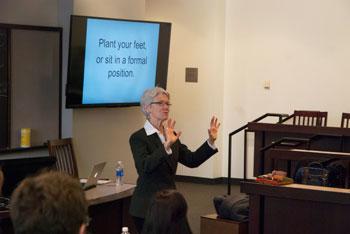Mastering the Nuances of Persuasion

Channeling adrenaline, building muscle memory, and developing an effective stance aren’t just for athletes. In today’s more collaborative, relationship-driven market, this training is essential for lawyers, too.
That’s why two recent Keystone programs brought in experts — a former professional ballet dancer turned social entrepreneur and a legal communication consultant who specializes in the science of human performance — to address the nuances of persuasion, from body language to extemporaneous speech.
“It’s not as easy as it looks to come up with something fluent, persuasive, and at least articulate, when you’re on the spot,” said Marsha Hunter, a communication consultant and the co-author of The Articulate Advocate: New Techniques of Persuasion for Trial Lawyers and The Articulate Attorney: Public Speaking for Lawyers. “But that’s the job of lawyers. No matter what you do in law school, and regardless of whether you’ve memorized certain things, once you’re out there, it’s all improv.”
Hunter's talk, which was sponsored by Schiff Hardin, focused on teaching students to think on their feet. She encouraged them to be mindful of how they move as they address an audience or jury, employing techniques that will channel the burst of adrenaline that typically accompanies public speaking.
“You need to tamp down adrenaline’s effects,” she said. “Quiet your legs and feet, and talk from the waist up. Deep breathing and standing still both lower adrenaline, and it will help flood your brain with oxygen.”
She also advised students to make eye contact, which fights the biological predator/prey response, and to offload nervous energy by gesturing with their hands, which takes advantage of muscle memory to help remember a narrative or argument. She also emphasized the importance of speaking slowly and taking pauses, noting that the brain monitors time through heart rate and that a pounding heart is apt to skew the interpretation.
John Michael Schert, who is the visiting artist and social entrepreneur for UChicago Arts and the Booth School of Business, encouraged law students to become more aware of their body language, noting that the majority of communication is nonverbal.
He told a story of a woman who always walked quickly at work and tended to keep her interactions short and focused, particularly when she was on the executive floor. Her colleagues saw her as busy, efficient, and in a rush, so they responded by keeping their conversations brief. When the colleagues revealed this in a workshop Schert was leading, the woman began to cry. She moved quickly because she felt unwelcome; her official, focused demeanor was an attempt to show she had a purpose, a reason for being on the floor.
“It was unconscious — she didn’t know she was putting off those signals,” he said. “She was teaching them that she was efficient and that their interactions with her should be very short. But that’s not what she wanted at all. She wanted to be welcomed in. She wanted casual conversation. Everything she did nonverbally undercut this.”
Schert encouraged the students to avoid this by paying attention to their physical signals and using muscle memory to help themselves broadcast messages that align with their goals.
“Locate in yourself the moments when you feel most relaxed and most confident, and pinpoint the places where you’re holding it,” he said. “And then when it counts, remember what that felt like, regardless of the new factors.”
He also encouraged students to know their power poses, the positions that make them feel the way they want to feel.
“Have a grab bag, an array of different options available to you,” he said. “And then you can execute them in different settings.”
Bethlehem Mebratu, ’16, said Schert’s talk made her more aware of her own body language.
“While I'm perceptive when it comes to reading others, I don't think I apply the same standard to myself, mainly because I naturally understand my own intentions,” she said. “After the talk, I realized that when I'm not confident about what I'm speaking about, I tend to hunch over more and don't have very good posture. I would like to work on that.”